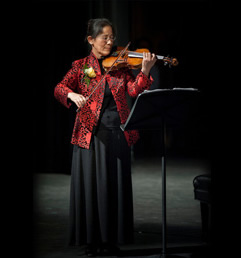This concert at Memorial Hall on the UNC-CH campus featured students as performing artists: symphonic instrumentalists under the direction of Tonu Kalam, and choral vocalists under Susan Klebanow. The concert began with the UNC Symphony Orchestra performing Beethoven’s Symphony No. 5 in C minor, Op. 67. The moment Maestro Kalam brought down his magic stick I knew we were in for a treat. In a noticeably up-beat tempo, Beethoven’s music unfolded, no, exploded upon our ears. The excitement was palpable. I recalled that the concert was about 15 minutes late getting started, probably due to the long line of ticket-seekers still outside the hall at the appointed start time. The woodwinds, brass, percussion and strings on stage did not waste any of the time. Whole sections and instrumentalists individually and together were going over some of the familiar symphony’s more challenging and tricky passages. I mention this because it bespeaks a passion and a dedication to the music that exuded throughout tonight’s performance. The first movement often misunderstood even by renowned conductors made stunning sense. The statement and development of themes flowed with a sense of urgency and excitement. It put me in mind of the glorious 1975 recording of Carlos Kleiber conducting the Vienna Philharmonic.
The second movement proceeded at a more relaxed tempo, as is proper, while maintaining a tension between lyrical beauty and unsettled expectation. The warm opening theme was stated by sixteen (I counted them) cellos. What a luxuriant sound! The third movement built incrementally in tension until it exploded into the heroic theme of the fourth movement, and what a magnificent sound that was.
The Fifth Symphony received its premier performance at a four-hour all-Beethoven concert at the Theater an der Wien in Vienna on December 22, 1808. The Sixth Symphony was first heard at the same concert. The Fifth was well received in spite of a poor performance. There had been only one rehearsal. It very quickly assumed the place it still holds today as the most popular classical Symphony and as the epitome of all classical music. As of a recent survey, there are over 300 recorded performances available on CDs; many of them great and some of them a waste of recording materials. The performance heard in this concert was not technically perfect. However, it would be frivolous to point out the few glitches when the overall performance attained “that wondrous spirit realm where grief and joy embrace (us) in the form of sound;” (attributed to E.T.A.Hoffman) the sound of Beethoven’s music.
After an intermission, the well-prepared Carolina Choir took the stage to perform Johannes Brahms’ Fest- und Gedenksprüche, Op. 109 (Festive and commemorative comments) composed for a national political occasion in 1888. The work is a set of three motets for double choir, composed in the expansive style of Heinrich Schütz, German composer who lived one hundred years before J. S. Bach. They are sung without accompaniment. The choir demonstrated a well-balanced and blended sound with precise articulation and solid ensemble.
The closing selection, Dona nobis pacem by Ralph Vaughan Williams was performed by the chorus and orchestra under the direction of Klebanow and with Louise Toppin, soprano and Richard L. Banks, baritone as soloists. The cantata, commissioned to mark the centenary of the Huddersfield Choral Society, was penned and first performed in 1936. It is acclaimed as one of the choral masterpieces of the 20th century and is an impassioned plea for peace at a time when the fear of global conflict was building.
The text uses verses from the requiem mass, the poetry of Walt Whitman, a political speech by John Bright and selected passages of scripture from the Bible. The phrase “Dona nobis pacem” (grant us peace), sung by the soprano soloist, is heard in the opening solo, is spaced throughout the piece and at the end. The centerpiece of the cantata is Vaughan Williams’ eerie and mystical setting of “Dirge for Two Veterans” which tells of the burial of a son and father who fell together on the battlefield.
O my soldiers twain! O my veterans passing to burial!
What I have I also give you.
The moon gives you light,
And the bugles and the drums give you music,
And my heart, O my soldiers, my veterans,<br </br
– Walt Whitman
Alas, the warning unheeded; the world was plunged into WW II and all the horrors attached to it. But still this powerful and moving music lives on, embedding itself in the consciousness of sensitive people who hear it. Perhaps yet, even if not in our lifetime, we will realize the answer to the prayer “dona nobis pacem” is in our hands, our choices.
The parents are rightly proud of their talented student-children, the student artists are pleased and gratified with their communal achievement, and the staff mentors are and should be thrilled and content. And we; we who reap the benefits of all their effort, we are grateful.
(Edited/corrected with thanks to an observant reader.)











